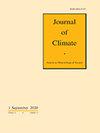Suppressive MJO in April 2014 downgraded the 2014/15 El Niño
IF 4
2区 地球科学
Q1 METEOROLOGY & ATMOSPHERIC SCIENCES
引用次数: 0
Abstract
Abstract The sudden halting of the extreme 2014/15 El Niño expected by many was attributed to the absence of westerly wind bursts (WWBs) in late spring and early summer 2014 in previous works, yet the cause of the lack of WWBs was overlooked. Using the ERA5 reanalysis and IBTrACS dataset, as well as a set of coupled model experiments, we showed that the absence of WWBs in May efficiently downgraded the intensity of the 2014/15 El Niño from a moderate to a weak event, and was closely associated with a strong suppressive MJO originating from the central tropical Indian Ocean in mid-April 2014. The suppressive MJO underwent two pathways once passing through the Maritime Continent in early May. Along the eastward pathway, the strong suppressive MJO prevailed over the western-central equatorial Pacific, directly prohibiting the occurrence of WWBs at the equator via inducing equatorial easterly anomaly. Along the northeastward pathway, the downward motions with relative dry air and strong vertical zonal wind shear associated with the suppressive MJO suppressed the activity of the tropical cyclones in the northwestern tropical Pacific, another source of WWBs. Our results indicate that the contributions of MJO to the development of El Niño from both the direct and indirect ways should be taken into account for improving El Niño prediction.2014 年 4 月压制性 MJO 使 2014/15 年厄尔尼诺现象降级
摘要 在之前的研究中,许多人将2014/15年极端厄尔尼诺现象的突然停止归因于2014年春末夏初西风暴发(WWB)的缺失,然而WWB缺失的原因却被忽视了。利用ERA5再分析和IBTrACS数据集以及一组耦合模式实验,我们发现5月西风带的缺失有效地将2014/15厄尔尼诺的强度从中度降为弱度,这与2014年4月中旬源自热带印度洋中部的强抑制性MJO密切相关。压制性 MJO 在 5 月初穿过海洋大陆后经历了两条路径。在东向路径上,强压制性 MJO 在赤道太平洋中西部占据主导地位,通过诱导赤道东风异常直接阻止了赤道 WWB 的发生。沿东北方向,与压制性 MJO 相关的相对干燥空气和强垂直地带风切变的向下运动抑制了热带太平洋西北部热带气旋的活动,这是 WWB 的另一个来源。我们的研究结果表明,在改进厄尔尼诺预测时,应考虑到 MJO 对厄尔尼诺发展的直接和间接贡献。
本文章由计算机程序翻译,如有差异,请以英文原文为准。
求助全文
约1分钟内获得全文
求助全文
来源期刊

Journal of Climate
地学-气象与大气科学
CiteScore
9.30
自引率
14.30%
发文量
490
审稿时长
7.5 months
期刊介绍:
The Journal of Climate (JCLI) (ISSN: 0894-8755; eISSN: 1520-0442) publishes research that advances basic understanding of the dynamics and physics of the climate system on large spatial scales, including variability of the atmosphere, oceans, land surface, and cryosphere; past, present, and projected future changes in the climate system; and climate simulation and prediction.
 求助内容:
求助内容: 应助结果提醒方式:
应助结果提醒方式:


